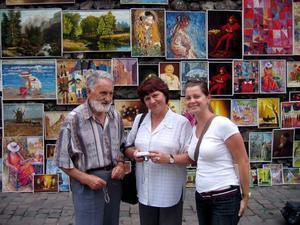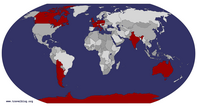Advertisement
Published: September 7th 2006

 Artist's Wall
Artist's Wall
Hanna & Jacek - Our Krakow guidesPrague - Katowice - Kraków (Train)
9-11, 14-15 August Kraków - what a city! It is the place of legend, intact medieval architecture (rare in Poland!), friendly people, “hearty” peasant food and the most bars per square kilometre… how could you not love this city?
It’s the first place we visit in Poland and also the first glimpse of half of my ancestry. My father’s family is Polish and I have fond memories of my nana’s bosom-filled embrace, accepting nature, her cooking and her heavily accented catch-cry every time she saw me: “You must eat! You are too skinny!” My grampa is still alive (at 93!) and we often see him sitting back on a chair, after a day of working hard in his vegie garden, enjoying a little cherry brandy in one of nana’s good crystal glasses (if she was around she would kill him). He always insists on giving us bags of vegies (mostly cabbage and potatoes these days) before we leave, and you can never say no them. It is one of my great regrets in life that I cannot speak either of my family’s languages, so on this trip I endeavoured to learn a
little of the Polish language, history and culture to play a bit of catch-up.
During the early Middle Ages, Western Slavs moved into the flatlands between the Vistula and Odra Rivers and became known as Polanians (“people of the plains”). In 966 they adopted Christianity in exchange for official recognition from Rome, but it wasn’t until the 1300’s that the kingdom was pulled together and united proper by Kazimierz III Wielki (the great). Kraków then began to flourish, becoming one of the leading cultural centres in Europe (the oldest University on the continent was established in Kraków in 1364).
Polish Proverb:
P?ynie Wis?a, p?ynie,
Po polskiej krainie,
Po polskiej krainie,
I dopóki p?ynie
Polska nie zaginie,
Polska nie zaginie. (Flows the Vistula, flows · Across the Polish land, · Across the Polish Land, · So long as she keeps flowing, · Poland shall stand, · Poland shall stand.)
For 500 hundred years Kraków was the capital city of Poland and Wawel Castle and the adjoining cathedral was the seat of Polish Kings. 100 Polish Kings and Queens are entombed in the catacombs below the cathedral, which you are free to visit (once you’ve paid the

 Wawel Castle - Krakow
Wawel Castle - Krakow
The view from the old townentry fee to the nuns in the ticket box - enforced collection plate?). One of the unconventional attractions of the cathedral is the bones of the local “dragon” chained to the outside of the church. Legend has it that the first castle was built on this prime site overlooking the Vistula River after Prince Krak came and slew the local dragon. The bones are actually elephant and whale bones but the poles don’t seem to worry about those kind of details - the bones are still pointed out to the tour groups with a cheeky smile as they enter the church. The Poles do attribute deeper meaning to these bones though; legend has it that if one of the bones should fall from the chains the cathedral will be destroyed, if they both should fall it will be the end of the world. They replace the chains every 2 years, just in case.
Useful Polish (phonetic): “tch toe yest twoy Smok?” (Is that your dragon?)
The castle overlooks two towns, the old town (inside the wall) and Kazimierz (outside the wall). In the 15th Century the Jews were expelled from the old town and forced to resettle in

 Dinner in the Cellars
Dinner in the Cellars
Polish heart attack food!Kazimierz. This town became the refuge for many Jews from all over Europe in the coming centuries and by the start of WWII there were 65,000 Jews (30% of Kraków’s population) settled in the area. During the war all the Jews from Kazimierz were transferred to a concentration camp on the other side of the Vistula River and killed - the events of this time was portrayed in the movie “Schindler’s List” by Steven Spielberg a few years ago.
Kazimierz is now re-emerging and becoming trendy after decades of loss and neglect and is now full of hip bars with hip young people sporting the latest haircuts. It is also full of tiny restaurants selling great home cooking - we had the best pierogi (ravioli like dumplings) here, we ate 3 different types from a choice of over 20, and the best barszcz (borshch, or beetroot soup) ever.
The food in Poland is hearty and filling, abundant in potatoes, pierogi dumplings, cabbage, and plenty of meat. “Peasant food” is making a resurgence and is regularly advertised to pull in the locals. These meals usually start with a basket of tasty food: fired bread with mugs of lard which has pork fat fried into it to use as a spread. So tasty, but oh so bad. The meals of pierogi, bigos (saurkraut with a variety of meats), and plack ziemniaczane (potatoe pancakes) are my nostalgia food after years of nana’s Sunday dinners when I was a kid. I’m eating so much of it that I pretty much feel sick after every meal.
Useful Polish (phonetic): “Mam Zahh-Vouh”. (I’m having a heart attack.)
The old town is centred around the Rynek G?ówny which is the largest medieval town square in Europe. At the corner of the square is Saint Mary’s Church (there is no shortage of churches in Kraków), where every hour a live trumpet trills from the highest tower. The 5-note melody that the trumpeter plays was played in medieval times as a warning call. It breaks off abruptly to symbolise the moment when, according to legend, the throat of a 13th century trumpeter was pierced by an arrow. Apparently there are about 5 people who volunteer to take turns trumpeting throughout the day. Thankfully these days the trumpeters are clapped at rather than shot at which I guess help the volunteer rate.
Useful Polish (phonetic): “G-rash na tromp-say?” (Do you play the trumpet?)
Not only are the Polish great trumpet volunteers they’re also generous with their help and advice for tourists. I also think the Polish are the friendliest people we’ve met yet on our trip. Even if they can’t speak English they’ll continue in Polish gesturing and smiling until they pat you on the shoulder and point you in the right direction (even if you weren’t asking for directions). In a small restaurant off the town square we meet two Kraków locals, Hanna and Jacek, who explain the menu to us and help us order local food. Hanna doesn’t speak any English, but can speak German well and Jacek can speak a little English. With my understanding of German, limited spoken German, and a few English sentences we are given an incredible insight to Kraków and it’s history as Hanna and Jacek generously chaperone us around the city for the next 5 hours. Both of them are retired, Hanna was a phycologist working at the university and is now an aspiring painter, Jacek was an engineer and knows every underground bar and restaurant in the city - I think. They have both lived in the city for most of their adult life and have seen it emerge from communist rule over the last decade or so. Hanna tells me with a revolutionist glint in her eye about the underground political meetings, poetry readings and the illegal satirical plays that she went to under Soviet-dominated communist rule. She also talks about the driving journeys across Europe they used to make in their trabant; laughing when she recounts people’s incredulity in Spain - “you came in that?”
Hanna is passionate about art and takes us to Kraków’s art hot-spots. First is a café that allowed the local artists to pay with their artworks instead of cash, which now adorn the walls. It’s also where Hanna and Jacek met and they treat us both to coffee and cake. Next is an outdoor gallery, which commandeers a section of the town wall to showcase amateur painters free of gallery fees. We then duck into the Church of SS Peter and Paul to admire the painted art nouveau glass windows before appreciating a touring exhibition of Olga Bozna?ska’s work, one of Poland’s most accomplished impressionist painters.
If Hanna’s passion is art, then Jacek’s is most certainly bars. Thanks to Jacek we visit over 10 bars and restaurants (though we don’t drink at them all), most of which you would never know existed. Kraków apparently has more bars per square kilometre than any other city in the world. One of the reasons for this is that a lot of them are underground. Most of the buildings were constructed with vast underground cellars below them to store the coal needed to heat the building, but once electricity was connected all that storage space was no longer needed… so they converted them to bars and restaurants. The national drink, wódka, is prolific in these places, but the poles also appreciate the taste of a zimne piwo (cold beer), which is available in big and really big sizes. Polish beer is also strong with “dog in a fog” beer going at about 10% alcohol. There are some other great spirits worth trying too like krupnik (honey liqueur) ?liwowica (plum brandy) and winiak (grape brandy).
Useful Polish (phonetic): “Zd’ruh, v koh!” (Cheers for beers!)
“Pull litR Wod-key”. (A large vodka.)
“toe-yest Moya Vong Troh-bah”. (It’s my liver.)
I feel privileged to have been shown Kraków by such knowledgeable and generous people - we had a camaraderie and a connection with Hanna and Jacek and now Kraków that transcended our age difference and languages that surprised me and made me proud of my heritage.
Useful Polish (phonetic): “Tch to yes Pol-ski-yeah?” (It’s a Polish thing, right?)
L
Advertisement
Tot: 0.215s; Tpl: 0.03s; cc: 15; qc: 70; dbt: 0.0621s; 1; m:domysql w:travelblog (10.17.0.13); sld: 1;
; mem: 1.2mb









